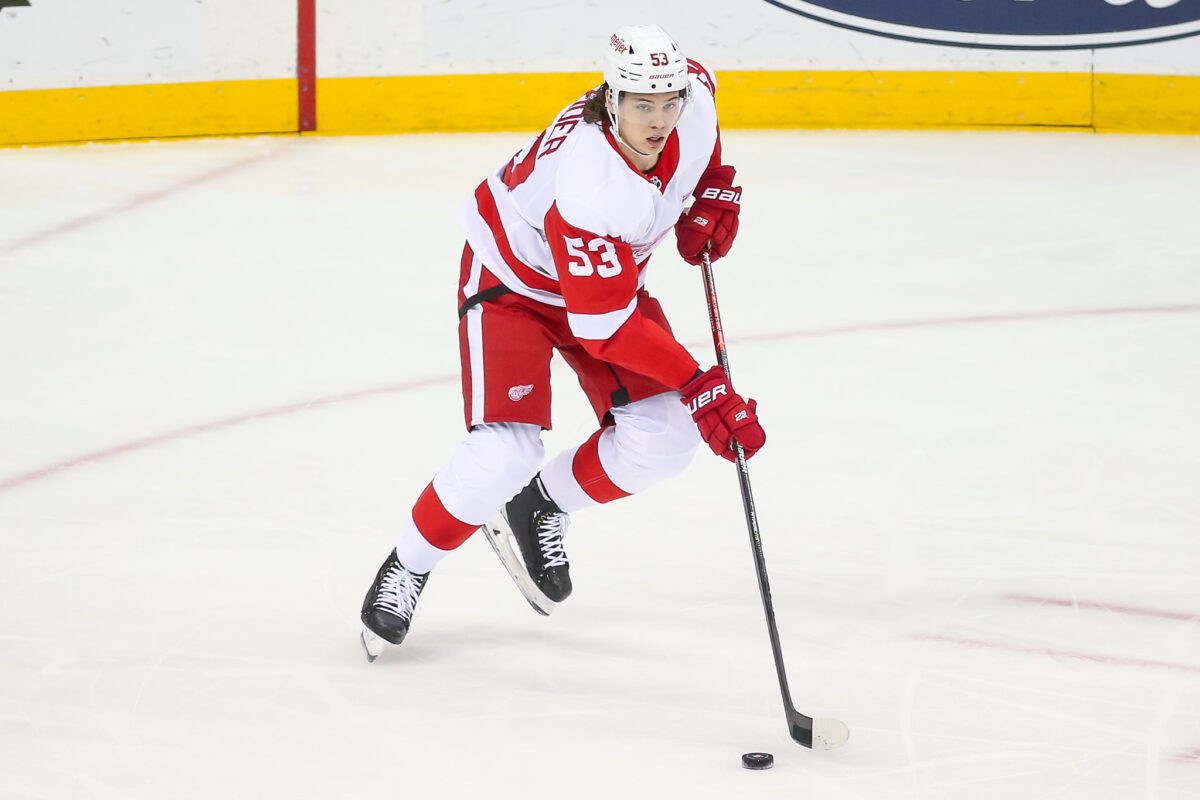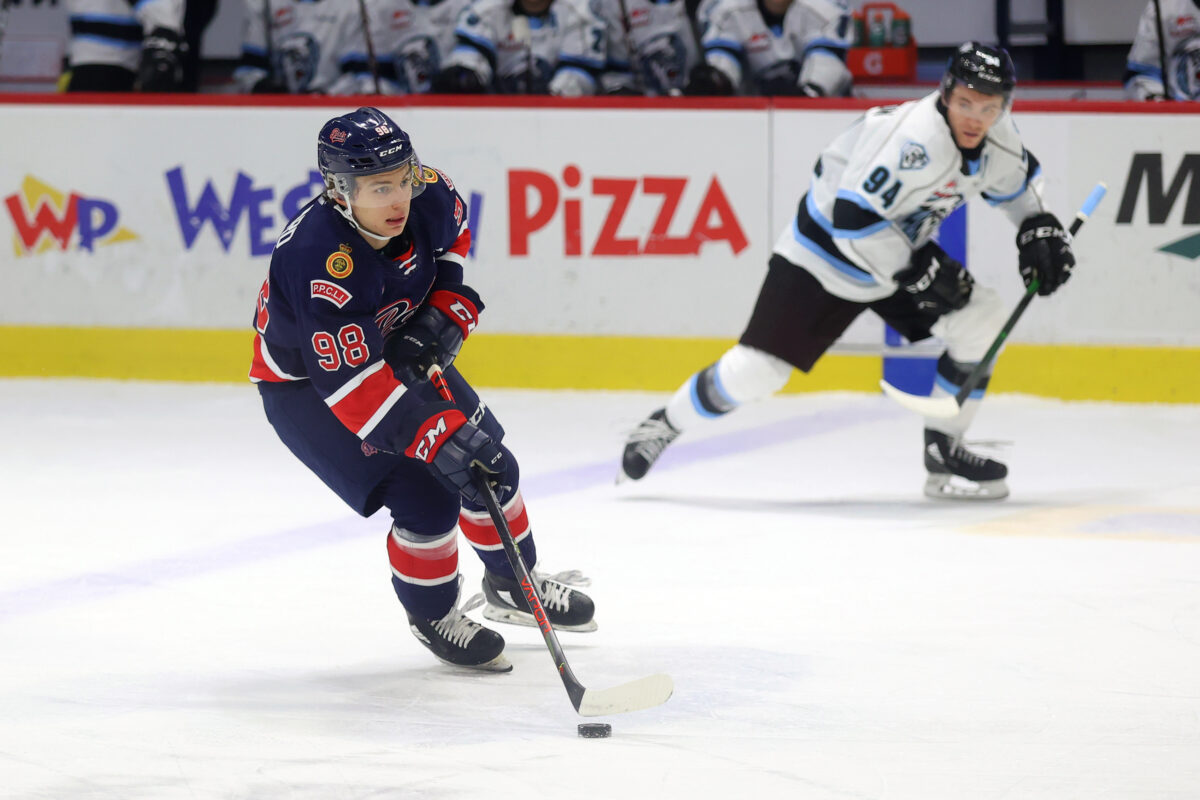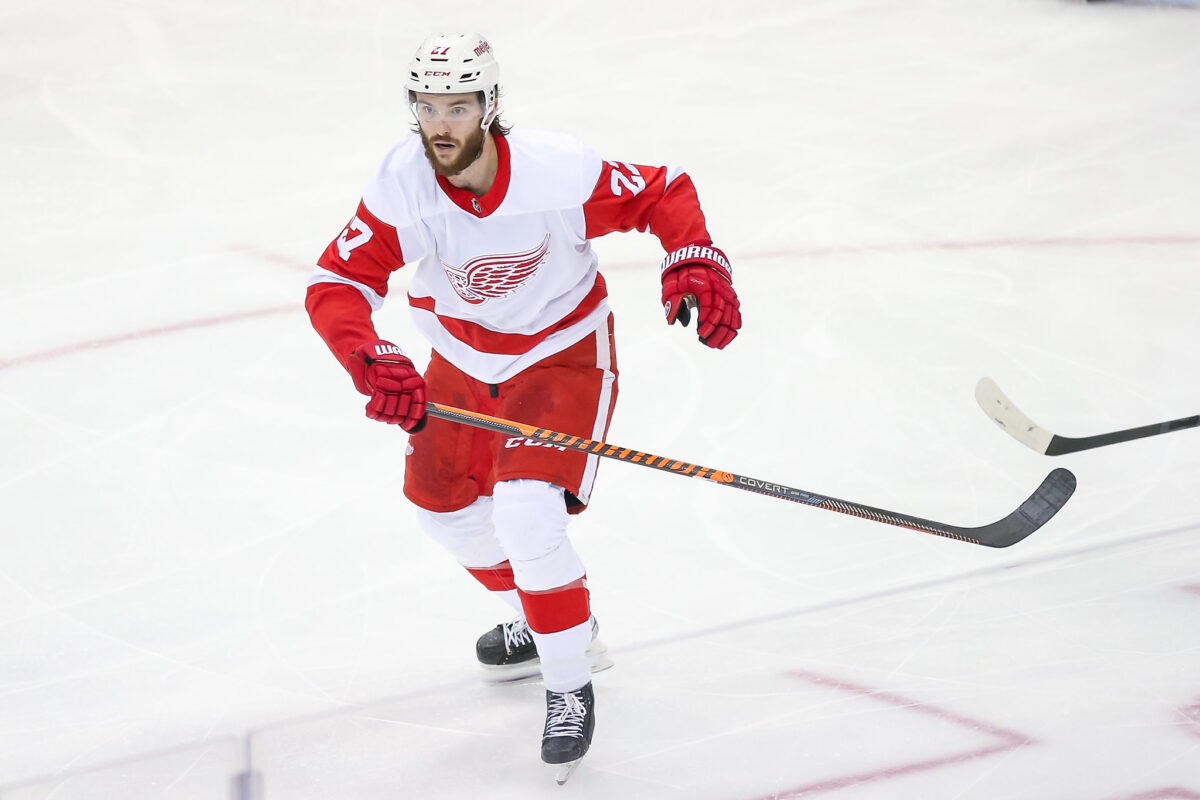Heading into the 2022 offseason, the Detroit Red Wings find themselves at a crossroad. They seem to be emerging from their rebuild with a competitive roster, but are not yet a playoff team.
With that in mind, we’ll conduct some scenario planning and examine the pros and cons of two distinct paths the Red Wings could take this offseason: 1) extending the rebuild even further and 2) committing to a playoff berth in the near future. In doing so, we can help uncover the ideal route Steve Yzerman should take.
2022 Red Wings Offseason Overview:
- Red Wings’ Year-Over-Year Team Analysis
- Red Wings’ Individual Player Progression/Regression in 2021-22
Option 1: Red Wings Continue Rebuild
First, we’ll dive into the possibility of prolonging the rebuild. Yzerman has always preached patience, and this path would require just that. By pursuing this option, the Red Wings would shift their rebuild to focus primarily on a core consisting of Moritz Seider, Lucas Raymond, Simon Edvinsson, and Sebastian Cossa. This wouldn’t mean trading Dylan Larkin, but rather making him the veteran on a team of early-20s up-and-comers.

The Case for Option 1
1. Red Wings still need more elite talent.
While the Red Wings have an impressive prospect pool and a solid roster, they’re not yet on the level of rebuild extraordinaires like the Toronto Maple Leafs, Los Angeles Kings, and New York Rangers. They still need a couple more cornerstone players to be true contenders. Remaining a bottom-dweller for another season or two would allow the Red Wings to draft elite talent that could drive the team forward.
2. Tyler Bertuzzi’s value has never been higher.
Detroit’s main trade chip, Tyler Bertuzzi, could bring back a substantial return if the Red Wings opt to deal him. Coming off of a 30-goal campaign, the 27-year-old winger has never held more value – but is also getting close to the end of his prime years. If it’s possible that Bertuzzi could attract an Anthony Mantha-type return, then why not seize on Bertuzzi’s peak value?
3. Seider and Raymond’s cohort are a less risky play than the current roster.
Finally, punting the rebuild down the road and building around Seider, Raymond, Edvinsson and Cossa is arguably safer than moving forward with the current roster. Bertuzzi, Robby Fabbri, Pius Suter, and Jakub Vrana are in their mid-to-late-20s now and carry legitimate risk of not being the keys to Detroit’s future success. They’re solid players, but not elite. Opting to build around other, younger players with superior pedigrees may better serve Detroit’s long-term sustainability.
Related: 2022 Red Wings Draft Coverage
The Case Against Option 1
1. There’s risk in missing out on top draft picks.
This one should be obvious. Despite the Red Wings finishing at or near the basement over the past six seasons, they have never received the No. 1 pick in the draft. In fact, the highest Detroit has picked is fourth overall. There’s no guarantee that more losing will result in the ability to draft future stars like Connor Bedard, Matvei Michkov, or Aron Kiviharju.

2. Even more losing breeds bad culture and subpar business.
So far, the Red Wings have been pretty resilient – not letting the doldrums of rebuilding get in the way of individual development. That said, we did get a glimpse of what too much losing looks like at the end of the 2021-22 season. The blowouts to the Arizona Coyotes, Pittsburgh Penguins, and Florida Panthers absolutely killed morale. If this team doesn’t improve soon, there could be detrimental impacts on team culture and player development.
In addition, you have to remember that Red Wings hockey is, in fact, a business. Tickets and merchandise need to be sold to help finance the team. The potential revenue implications tied to more losing should be evaluated as well.
3. There’s no guarantee that a prolonged rebuild will work.
My wife likes to joke(?) that the Red Wings have been rebuilding forever. There’s some truth to that. But it makes you wonder, will a continued/second rebuild work? It’s entirely possible that the Red Wings arrive at another crossroad five years from now. The risk of not succeeding in rebuilding the organization a second time needs to be considered.
Option 2: Red Wings Push for Immediate Success
This approach is the polar opposite of Option 1 – accelerate the rebuild and push to make the 2023 postseason, and do so without mortgaging the future.
The Case for Option 2
1. The current squad is not that far off from being a playoff team.
It’s not unreasonable to say that Detroit’s roster is close to that of a playoff team. If you think back to the first half of the 2021-22 season, the Red Wings were a competitive team that had a chance to win most nights – while playing without Vrana.
Goal scoring improved during the 2021-22 season under Alex Tanguay, and contributors like Michael Rasmussen, Filip Zadina, and Robby Fabbri progressed both offensively and defensively. With the right head coach and a proper system in place, there’s enough talent on this roster to squeak into a wild card spot.

2. Detroit’s healthy salary cap picture can facilitate additional moves.
With only Jordan Oesterle signed through the 2022-23 season, the left side of Detroit’s defense needs to be addressed. Luckily, the Red Wings have about $36.5 million in cap space available and only a couple restricted free agents to sign, with Zadina being the most significant. They can easily afford to add a couple impact free agents like Valeri Nichushkin, Andre Burakovsky, Vincent Trocheck, Ben Chiarot, or Josh Manson without harming their salary cap outlook moving into the future.
3. Other teams have done more with less.
Make no mistake, the Red Wings are not a powerhouse. But neither were the Dallas Stars nor the Montreal Canadiens when they reached the Stanley Cup Final in 2020 and 2021, respectively. Overachieving next season and reaching the playoffs could fuel even greater development among Detroit’s young players – more so than another losing season.
The Case Against Option 2
1. Additional mediocrity could follow.
There is some risk in pushing for a postseason berth. Most obviously, it may not work. Detroit could add a few key players who take up valuable salary cap real estate only for the team to fall flat once again. A false start could set the team back even further.
2. The Detroit Pistons serve as a cautionary tale.
Mediocrity is arguably worse for the franchise than tanking – good enough to win a few games, but not bad enough to earn favorable odds in the draft lottery. It can be perpetual, too – just look at the post-Flip Saunders and pre-Dwane Casey Detroit Pistons. They kept pushing for the playoffs, coming up short, and receiving subpar draft slots in return. It wasn’t until Troy Weaver tore it down for the Pistons to finally land a franchise-changer in Cade Cunningham.
3. The 2022 free agent class lacks star power.
There aren’t many game-breaking free agents available in this summer’s class, so financing a quick turnaround comes with some risk. The free agent targets noted above—Nichushkin, Burakovsky, Trocheck, Chiarot, and Manson—are solid players, but not stars. As I said above, the Red Wings need more elite talent on the roster to succeed.
Related: Grading Steve Yzerman’s Tenure as Red Wings GM
Assessment of Detroit’s Options
When considering scenario planning options, the risks and rewards of each should be evaluated, along with their likelihood of happening. It’s ultimately up to the decision-maker to review the information at hand, determine their risk tolerance, and choose the path forward.
My recommendation would be to capitalize on Bertuzzi’s peak value and trade him if a first-round pick plus additional draft choices/prospects/young players are offered. Then, I’d suggest replacing Bertuzzi with a free agent like Nichushkin, Burakovsky, Trocheck, or Nino Niederreiter, and otherwise pursue Option 2: push for immediate success. This rebuild does not need to be perfect. Perfect is the enemy of great, after all.
That’s just my recommendation, though. My job is not on the line here, which is why I can accept the risk associated with this avenue. Yzerman may have a different risk tolerance. You might have a different one, as well.